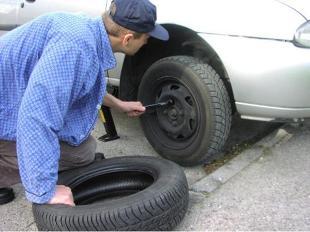
Winter boxes are not suitable for summer
 The fact that summer tires are dangerous in winter is well known to most drivers, but what are the aspects of not using winter tires in summer?
The fact that summer tires are dangerous in winter is well known to most drivers, but what are the aspects of not using winter tires in summer?
The fact that summer tires are dangerous in winter is well known to most drivers, but what are the aspects of not using winter tires in summer?
In the course of a survey conducted jointly with the Renault driving school, to the question “Do you replace winter tires with summer ones?” 15 percent answered "no" people. In this group, 9 percent say it's too expensive and 6% say it doesn't affect driving safety. There are also those who, although changing tires, do not see a deep meaning in this (9% of survey participants answered this question).
The Road Traffic Law does not oblige drivers to change tires from summer to winter or vice versa, so drivers should not be afraid of a fine, but it is worth knowing what problems are associated with using the wrong tires.
The issue can be viewed from several angles. First of all, safety aspects speak in favor of replacing winter tires with summer ones. Winter tires are made from a much softer rubber compound than summer tires, and the tread pattern is adapted mainly to the fact that the tire "bites" into snowy and muddy surfaces, due to which its contact surface with the surface is smaller than in the case of summer tires. This design means that the braking distance in extreme cases, according to ADAC, can be longer, up to 16 m (at 100 km/h).
In addition, such tires are much easier to puncture. Getting such a tire into one of the holes left after the winter season can cause it to burst much earlier than in the case of a harder summer tire. Also, hard braking, especially on a non-ABS equipped vehicle, can result in complete destruction due to tread point wear.
Another factor in favor of changing tires is the net savings. Winter tires that are warmed up in hot summer weather wear out much faster. It is worth recalling here that winter tires are on average 10-15 percent more expensive than summer tires. In addition, a "more powerful" tread pattern results in more rolling resistance and therefore higher fuel consumption. However, in the latter case, experts say that with a tread depth of less than 4 mm, rolling resistance and braking distance are comparable to summer tires. The only justified reason for using winter tires in summer is the so-called. When the tire has a tread depth of less than 4mm, i.e. when it is considered that the tire has lost its winter properties, and the tread still meets the requirements of traffic rules, i.e. it is deeper than 1,6 mm. At this point, environmentalists will say it's better than throwing away only a half-worn tire, and drivers should be aware of the risks associated with riding such tires.
Perhaps least important, but no less onerous, is the issue of driving comfort. These tires are much louder when driving, you can often expect disturbing sounds in the form of squeaks, especially when cornering.
If we have to use winter tires, the driving style must also be adapted to this situation. A less dynamic start will reduce fuel consumption despite higher rolling resistance. Cornering should also be done at lower speeds. All sorts of tire creaking means that the tire is slipping, and secondly, it wears out during this time much more than during normal driving. When driving, the fact of a longer braking distance must always be taken into account, so it is advisable to keep a greater distance from others and maintain lower speeds.
According to the expert
Zbigniew Veseli, director of Renault driving school Driving on winter tires in the summer is very dangerous. The tread pattern and type of rubber compound means that on hot days the stopping distance is longer and when cornering the car feels like it is "leaking", which can lead to loss of control and an accident.

